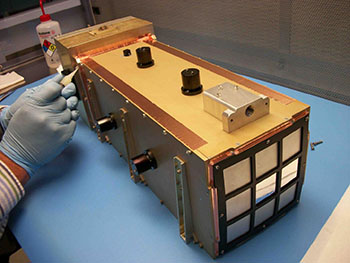
The integrated lobster-eye optics instrument prototype with the optics holder at the front. Credit: NASA
A NASA-led interdisciplinary group of scientists reports initial results from the space launch of a prototype wide field-of-view (FOV) soft X-ray imager (Rev. Sci. Inst., doi: 10.1063/1.4927259). The proof-of-concept imager uses “lobster-eye” optics to detect soft X-ray emissions, which are released by ions in solar wind when it mixes with a neutral gas. The authors say that imaging solar wind’s interaction with the Earth’s magnetosphere could help protect satellites and other space assets against damaging space weather caused by solar winds. In addition to these heliophysical applications, the researchers say the lobster-eye imaging technology could also be applied to planetary and astrophysical science.
Solar wind is created when plasma from the sun interacts with a neutral gas—like the residual atmosphere in Earth’s magnetosphere. The wind is made mostly of protons and a smaller percentage of high-charge-state heavy ions. When these ions interact with the neutral gas, they acquire an electron in an excited state, which causes them to release soft X-ray photons—these are the X-rays the lobster-eye imager is designed to detect.
The researchers chose a micropore (lobster-eye) setup for their optical element because it provides a much larger FOV than traditional nested mirror optics. The lobster-eye design allows the imager to pick up large-scale structures in space, such as the terrestrial cusp and planetary bodies. The imager consists of an array of 20 µm-square glass micropores that increase the reflecting surface and effective area of the optics. An optics holder accommodates up to nine of these arrays, called micropore reflectors (MPRs). Together, they offer a 9.2° field-of-view, side-to-side, and a 75-cm radius of curvature and 37.5-cm focal length. For budgetary reasons, the prototype that was launched was flown with only two of the nine MPR slots populated.
The imager, combined with a camera, was launched into space on a Black Brant rocket in December 2012. The imager survived a particularly bumpy ride into space and completed four full sky scans, detecting soft X-rays emitting from a helium focusing cone. The authors found the imager’s observed count rate of soft X-rays consistent with their pre-flight expectations. They also report consistent imaging between the two populated MPR slots based on a statistical analysis correlating the counts observed in the same region of the sky between the first and second scan.
The authors believe that this trial-run represents “an important milestone in establishing global magnetosheath, cusp, and solar wind-planetary interaction imaging.” Future research plans include exploring the technology’s potential applications in exploring other planets with neutral gasses. The lobster-eye optics could also be added to low-cost, compact nanosatellites (e.g., CubeSats) that promise a high science return on investment.
